Mary Louden (Yellow Corn) Acoma Pueblo Indian Pottery, Polychrome
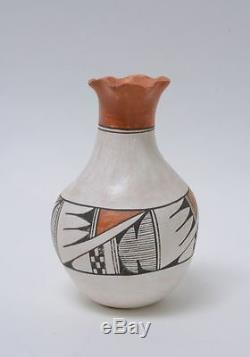
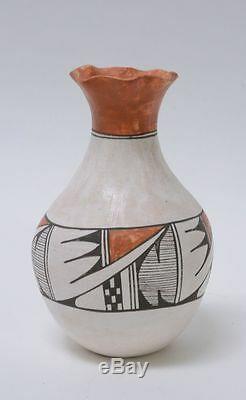
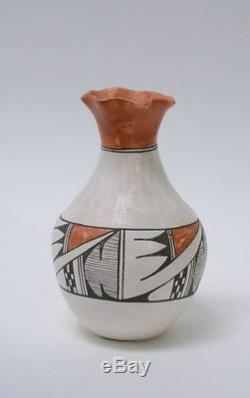
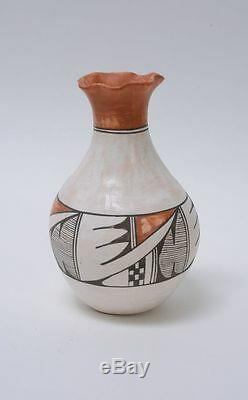
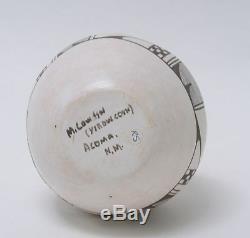

Antique American Indian Art, LLC. Handsome value in excellent condition. Here is an interesting article on Mary I found on the net.. Acoma potter sculpts everyday life into clay figurines.
AIANTA Travel Writer, American Indians and Route 66. Mary Lowden is a storyteller, and in each of her stories there is a Beer Can. Beer Can is always there whether he has a stray corncob in his mouth or is seated at the feet of the Virgin Mary in Lowdens version of the Christmas Nativity scene. Beer Can is my brothers dog, she explains laughingly. She points Beer Can out in each group of the collection of Acoma clay sculptures she has arranged on a shelf.
All of the figures are hand-coiled, made of local clay she has shoveled from the earth and processed by hand. The raw clay has to be soaked into a liquid and all the sand and gravel strained away. Then the clay must be left to set up and dry. This is our native clay.One of these days, before it gets too cold, I need to walk out there and dig some before it warms back up and the snakes are out, Lowden says, shrugging as if the snakes are merely a worrisome part of the process. Lowdens figures tell the stories of her life and the life of her village at Acoma Pueblo.
She says its one thing to hear the stories but another to see them, and seeing the ceremonies is rare outside of the Pueblo community. Photography and video is strictly forbidden during most events. She gestures to a photo of her daughter Artie. I do things like [her making] her first cornmeal, she said. I said, Thats a long thing sweetheart. You have to take so many the days off. You have to plant your corn and get your Indian moccasins made and your dresses made, Lowden says. We did that all in one year.She points to a set of figures on the shelf. She had rendered the occasion in clay. We got the men folk sitting in the back, and she is sitting there grinding her first corn.
Beer Can is sitting there, too, with a corncob between his teeth. You can still smell the clay, she says. She takes a piece that needs dusting off the shelf and dunks it under a shot of running water from the kitchen sink. The faint odor of raw clay permeates from the piece. It wont hurt it none.You just sit it down to dry, she says, placing the newly dust-free figure to the side. She sculpts her family, the people she sees and events in her life. During our Winter Solstice, we do the Gathering of the Stars ceremony.
So I did a man standing there and the lady standing there holding a basket of stars. You know, things that happen in my village, she says. Lowdens village, the Acoma Sky City Pueblo, is the oldest continuously inhabited settlement in North America, and the pottery of its people is recognized for fluted rims, thin walls and geometric design, according to information from the Pueblos cultural center. Lowdens mother, aunts and grandmother all made pottery.She grew up around the clay and she used to make pots herself until her husband Alvin walked on. After my husband I just I just didnt want to do it anymore. I just stopped, she says.
But as a girl, she helped with the pottery. She and other girls from the village would take the pottery they and their families made to a little general store on Route 66. They would make us go sell it. Albuquerque was a more than 64-mile trip east down Route 66 from the Pueblo.After boarding school, Lowden enrolled in nursing school. She stopped short of getting her degree. A thyroid condition kept her out of her final semester of school. She says she would have gone back, but by then she had met Alvin. About that time, I think everything was shutting down on the main area (on Route 66).
Everyone my age was growing up and going off to school or off to Relocation, she says. Lowden is referring to the Indian Relocation Act initiated by the federal government in 1952. Relocation offices were established in seven major cities, including Chicago at the east end of Route 66 and Los Angeles at the west. By that time they were telling everyone to join the Relocation.
So I said to Alvin, Why dont you go and sign up and go and do something instead of staying here? But Alvin wanted to stay home. He grew up at Acoma and was happy being a sheepherder. After putting his time in the military, he came home and wanted to stay home. I saw some of our friends.They were drinking and all that stuff, and I wanted something more, Lowden says. Even Lowdens grandmother wanted them to stay at Acoma.
She wanted them to stay with them. They had corn and alfalfa fields that Alvin could help with. She pressed Alvin to join until he gave in.
He signed up and they were to be sent to Chicago, but she was pregnant and there werent any Indian Health Service facilities in Chicago. They decided to wait for the baby. She had her baby in February that next year and they stayed until the baby got her Indian name and was baptized.
Then, in 1966, the family packed up for Chicago, where Alvin would go to heavy equipment school. The area office gave us papers and told us to get on the train in Grants (a town about 45 miles to the west of Acoma on 66) and go and take whatever you can and somebody will meet you at the YMCA. Alvin and Mary were told to check in at the YMCA when they arrived. We didnt know what YMCA was, and we arrived late at night and finally somehow we got to the YMCA and stayed overnight. The next morning my husband called the area office, and a lady that was from the area office helped us around, she says.
Oh, that was somewhere to go. We arrived at the time that Richard Speck killed those eight student nurses. We were there during that time. Alvin was enrolled in a school to learn to operate heavy equipment in a community about 60 miles outside of Chicago.
One of our counselors came and took us over there. There were trailers for us to live in, and they gave us a little stipend to live on, Lowden says. Once he completed training, Alvin got a job right away and they rented an apartment from an Italian couple. She soon began to know their neighbors and making frybread to sell.
People would ask us if we were really Indian, where we lived it was like we were on display, she says. Chicago was good to them, she says. Their family would visit when they could, taking the Santa Fe Railroad, also known as the Route 66 Railway.
However, it was a family tragedy that brought them back to Acoma. Lowdens grandparents were killed in a car accident. We would have stayed in Chicago. Alvin had work, and we had made a home. But we had to go back to help care for my family, Lowden said.Alvin eventually found work in the nearby uranium mines and Mary started making pottery again. Alvin has since walked on and Mary lives there today with her son and grandson. Acoma Pueblo is located off of I-40, 52 miles west of Albuquerque, exit 108, south 12 miles on CR 12A. Welcome to Matt Wood's Antique American Indian Art, Inc.
We are confident that you will be pleased with the value, service and peace-of-mind that our gallery can offer you. We will be adding lots of quality Antique American Indian Art over the next few months. The item "Mary Louden (Yellow Corn) Acoma Pueblo Indian Pottery, Polychrome" is in sale since Thursday, April 11, 2019. This item is in the category "Collectibles\Cultures & Ethnicities\Native American\ US\1935-Now\Pottery". The seller is "antique-american-indian-art-llc" and is located in Aliso Viejo, California. This item can be shipped to United States.- Country/Region of Manufacture: United States
- Tribal Affiliation: Acoma
- Artisan: Mary Louden
- Featured Refinements: Native American Pottery

